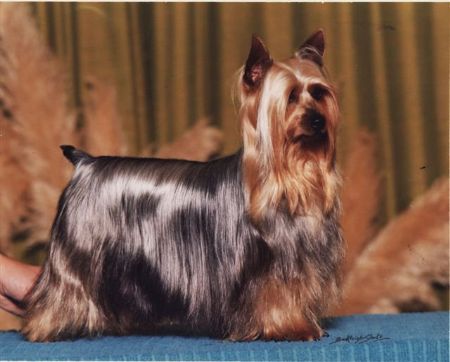BREED HISTORY

The origins of the Australian Silky Terrier may never be known. All we have are myths and stories as to the creation of this wonderful companion.
Our story begins sometime in the late 19th century during the haphazard cross breeding that eventually produced the Australian Terrier. The English immigrants that travelled to Australia were only allowed to bring the various small terrier dogs due to the space and food restrictions that existed on the sailing ships of that period. The early colonials needed a dog to control rodents and also watch animal stock on their properties. Several English terriers were cross bred to produce what was then known as the rough or broken coated terrier. The list of terriers is thought to include the Skye, Black and Tan, Scottish, Paisley, Clydesdale, Waterside, Norwich and Roseneath terriers. The Broken Coated Terrier appeared in the 1872 Royal Melbourne Show with exhibits divided into two classes, under and over 7 pounds. The less than 7 pound class was later known as the Broken Coated Toy Terrier. In 1888 the exhibits were known as the Broken Coated Blue Terrier, although blue and tan eventually became the accepted coat colour. It is thought that at this stage of the breeding program the Broken Coated Terrier became known as the Australian Terrier. The new terrier came in two distinct groups, the first with a course wiry coat and the second with a soft textured coat. The successive breeding programs strengthened the characteristics of each group. The Tasmanian Broken Coated Terrier breeding program is said to have introduced the Dandie Dinmont Terrier to further soften the coat and improve the top knot. A Toy Terrier, Sandy or Silky Coated, was exhibited at the Tasmanian Agricultural Pastoral and Horticultural Society show in 1875. At some stage the Yorkshire Terrier was also introduced into the breeding program, initially to develop the blue and tan colour and then later to improve the texture and length of the soft coated Australian Terrier. A structured breeding program continued to further refine and develop the breed.
The first breed standard was drawn up by the Victorian Silky Terrier Club. This club was later superseded by the Victorian Silky and Yorkshire Club in 1904. 1906 saw classes for the Silky Coated Terrier begin to appear at a large number of shows. In 1908 the Victorian Silky and Yorkshire Terrier Club applied for separate classes at shows. However, it wasn't until 1911 that separate classes were recognised by the Victorian Poultry and Kennel club. Around 1906 another breed standard was introduced in New South Wales where the breed was commonly referred to as the Sydney Silky. In 1934, the Kennel Control Council (KCC) introduced special regulations which essentially prohibited cross breeding between the Silky, Yorkshire and Australian terriers. As a consequence, the breed quickly stabilised. Following consultation with all Australian states, the breed was officially recognised as the Australian Silky Terrier in the June 1956 edition of the KCC Gazette. A complete Australian wide agreement was not achieved until 1959. At this time, the newly formed Australian National Kennel Council accepted the standard and breed name for the Australian Silky Terrier.
The present Australian Silky Terrier Club of Victorian was formed on 4th February 1958. The President elect was Mr. F A Longmore and Secretary Mrs. E Collins. This article prepared by members of the Australian Silky Terrier Club of Victoria.
Acknowledgments References:
Australian Silky Terrier Today by Hingeley, Marshall & Wren. 1997.
Australian Born Australian Bred. The Australian Silky Terrier by Jan Boyce. 1997.
KCC Gazette, January 1936 and June 1956 editions.
Dogs Life, March/April 2007 edition.
Silky Terriers by Alice J Kane 2005.
Contact Details
James W CamacCardigan, VIC, Australia
Phone : 03 53448238
Email : [email protected]
